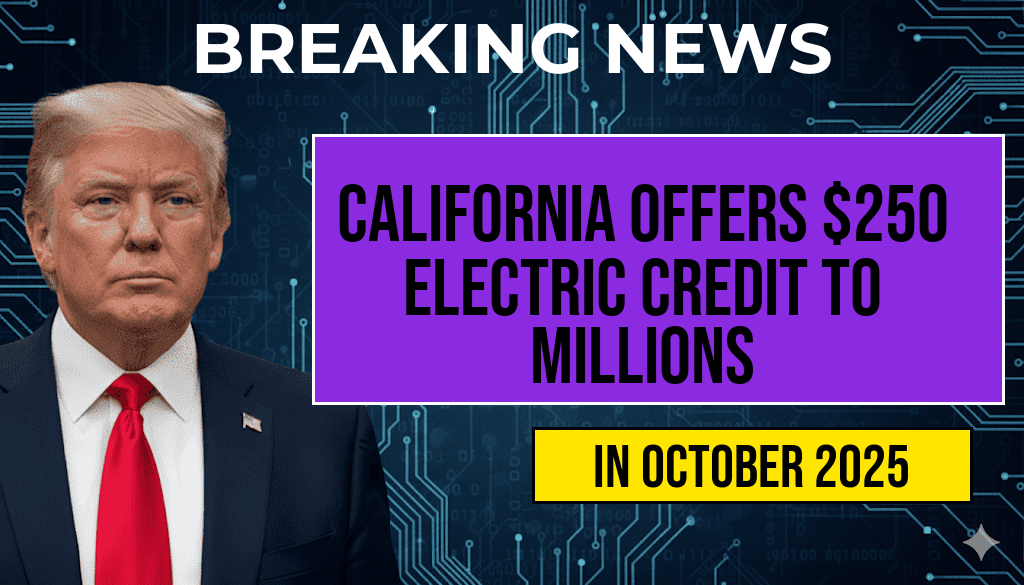California has announced a new initiative to provide direct financial relief to over 11.5 million households across the state. Under the program, eligible residents will receive payments of up to $250 per household, aimed at offsetting the rising costs associated with electricity bills. The payments are designed to be simple and accessible, requiring minimal effort from recipients, and are part of the state’s broader efforts to support residents amid economic pressures and increasing energy costs. This initiative underscores California’s commitment to delivering targeted financial assistance efficiently, leveraging existing electric credit programs to speed up disbursement and reduce administrative burdens.
Details of the Electric Credit and Payment Distribution
Eligibility and Distribution Process
The program primarily targets households that are already participating in California’s electric credit schemes, which are typically aimed at low- to moderate-income residents. To streamline the process, the state has integrated the payment distribution with current utility billing systems, ensuring that recipients automatically receive their credits without submitting additional documentation.
- Eligibility: Households enrolled in existing electric assistance programs or meeting income criteria.
- Payment Amounts: Up to $250 per household, based on specific eligibility factors.
- Distribution Method: Direct deposit or applied as a credit on utility bills, depending on the household’s preferred method.
- Timing: Payments are expected to commence within the next month, with most households receiving their funds before the end of the quarter.
Minimizing Administrative Burdens
By relying on existing infrastructure, California aims to ensure that the process remains hassle-free for residents. The state’s Public Utilities Commission (PUC) has coordinated with utility providers to automate the delivery, removing the need for households to navigate complex application procedures. This approach not only accelerates the timeline for distribution but also reduces administrative costs, allowing the program to reach more residents quickly.
Rationale Behind the Program
Addressing Rising Energy Costs
California has experienced a significant increase in electricity rates over the past year, driven by factors including supply chain disruptions, higher fuel costs, and increased demand. These rising costs have put financial strain on many households, particularly those with limited income. The direct payments aim to provide immediate relief, helping families manage their utility bills without resorting to cutbacks or financial hardship.
Supporting Economic Stability
Governor Gavin Newsom emphasized that the initiative is part of a broader strategy to bolster economic stability for Californians. By offering straightforward assistance, the state hopes to mitigate the impact of inflation and ensure residents can maintain essential services such as electricity. This move aligns with California’s ongoing efforts to reduce energy burden among vulnerable populations and promote equitable access to energy resources.
Financial Impact and Broader Context
| Number of Households | Maximum Payment per Household | Total Estimated Cost |
|---|---|---|
| 11,500,000 | $250 | $2,875,000,000 |
The program’s estimated cost is approximately $2.88 billion, which the state will fund through a combination of federal aid, energy revenue allocations, and budget reallocations. Officials maintain that the investment is justified given the immediate relief it provides to millions of households and the potential long-term savings associated with reduced utility disconnections and financial hardship.
Comparison with Past Initiatives
This direct payment approach echoes previous efforts by California to cushion residents from economic shocks, such as utility bill assistance programs during past energy crises. Unlike traditional rebate or voucher systems, the current initiative emphasizes ease of access and minimal paperwork, reflecting lessons learned from earlier implementations that faced delays and administrative hurdles.
Expert Perspectives and Future Outlook
Public and Industry Reactions
Energy analysts and consumer advocates have largely welcomed the program, citing it as a timely response to ongoing economic challenges. Consumer rights groups have highlighted the importance of transparent communication and ensuring that eligible households are aware of the benefits. Utility companies have expressed support for the effort, noting that it could reduce late payments and disconnections, thereby stabilizing the local grid.
Potential for Expansion
Officials have indicated that if the initiative proves successful, similar models could be adopted for other utility services or expanded to include additional demographic groups. The program also serves as a pilot for future direct assistance strategies, leveraging technological infrastructure to deliver financial aid swiftly and effectively.
For more information on California’s energy programs and assistance initiatives, visit the Energy in California page on Wikipedia or consult the Forbes energy section.
Frequently Asked Questions
What is the purpose of California’s direct payments to households?
The purpose of California’s direct payments is to provide electric credits of up to $250 to over 11.5 million households, helping offset energy costs and support residents with minimal effort.
How will households receive the electric credits?
Eligible households will receive the direct payments automatically, with no need for additional application or paperwork, making the process simple and efficient.
Who is eligible to receive the up to $250 payment?
Most residential households in California are eligible, particularly those that qualify for existing energy assistance programs or meet specific income criteria.
When will the payments be distributed?
The distributions are expected to be made in the coming months, with the exact timing depending on program implementation and administrative processes.
How does this initiative help address energy costs in California?
This initiative provides financial relief by offering electric credits directly to households, reducing the burden of energy expenses and promoting cost savings across the state.






